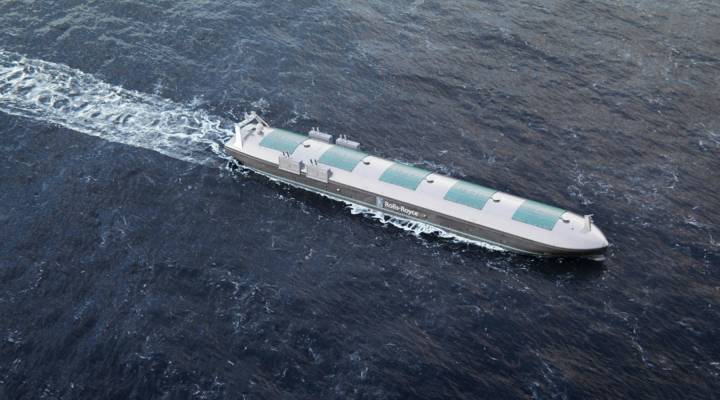
I am the Captain now: self-driving ships coming soon

We all know about self-driving cars, an idea that is exciting and terrifying all at the same time. The next big thing — make that really big — is self-driving ships. Research on autonomous vessels is picking up steam around the world.
Some of it is on a small scale, like a project at the California State University Maritime Academy in Vallejo, California, north of San Francisco. Mechanical engineering professor Michael Holden and his students used off-the-shelf components, including the guidance system for a quadcopter drone, to build a 4-foot-long boat that follows a pre-set course using GPS readings.

Michael Holden, associate professor of mechanical engineering at the California State University Maritime Academy, launches his miniature autonomous ship into the Carquinez Strait near San Francisco Bay.
“An autonomous system needs a mission. So this one’s mission is to measure the water quality in the bay,” he said.
Currently, that type of work is done using full-sized boats and a crew. It is tedious and labor-intensive. Automating the process allows a single operator to see the data show up on a laptop computer, and tend to other work while the autonomous boat does its thing.
Holden’s students are comparing the scientific readings taken by their mini-boat to the readings from manned vessels to determine if a drone boat is a viable alternative.
“It’s not bleeding edge,” he said, but certainly on the leading edge of the technology.

With 1,200 students training for a variety of maritime careers, the California State University Maritime Academy in Vallejo, California is one of only seven degree-granting maritime academies in the United States.
But the real excitement surrounding autonomous vessels involves full-sized cargo ships that will be able to carry cargo across vast oceans at a fraction of the current cost.
“We think this is something that’s going to redefine shipping,” said Oskar Levander, vice president for Innovation, Engineering and Technology for Rolls-Royce, who is based in Finland.
A six-minute video released by the company earlier this year looks and sounds like a science fiction movie, complete with a talking computer that does everything from diagnosing problems on the ships to reminding the operator to take a coffee break. The video envisions a crew of as few as seven people operating a fleet of autonomous ships from a land-based control center.
Levander insists the video is no fantasy.
“Time frame-wise, we say that we’re going to have one of these vessels in commercial use before the decade is out. So that’s four years from now,” he said.
Levander said the project is a major priority for Rolls-Royce, though he would not disclose the specific resources the company is putting behind it, citing corporate policy.
Backers of the concept, and even some skeptics, acknowledge that the potential savings are huge. Today’s manned vessels carry a crew of 20 or more people, all of whom need to be housed, fed and paid. An unmanned vessel needs no space for a crew or provisions, and because it never sleeps, it can travel day and night, saving time and fuel.
Levander expects the first self-driving ships will operate within a single country’s borders. That’s because before trans-oceanic vessels can operate, entire laws will need to be re-written.
Cal Maritime’s interim academic dean, Samuel R. Pecota, said that is a major reason that U.S. firms have been far more cautious about the concept.
“The international collision regulations—rules of the road—are based solely on manned vessels. There’s nothing written in there about autonomous vessels,” he said.

Samuel R. Pecota, interim academic dean of the California State University Maritime Academy, said numerous policy issues need to be worked out before widespread use of autonomous ships can become a reality.
He agrees the vessels are inevitable, but says many safety concerns need to be addressed, particularly when unmanned vessels are operating in the same waterways as manned ones.
But Rolls-Royce’s Oskar Levander points out that most shipping accidents are the result of human error.
“We actually foresee that the unmanned ships will be safer than the current ships today,” he said.
In this case, a project that has no one on board is a good thing.
There’s a lot happening in the world. Through it all, Marketplace is here for you.
You rely on Marketplace to break down the world’s events and tell you how it affects you in a fact-based, approachable way. We rely on your financial support to keep making that possible.
Your donation today powers the independent journalism that you rely on. For just $5/month, you can help sustain Marketplace so we can keep reporting on the things that matter to you.












